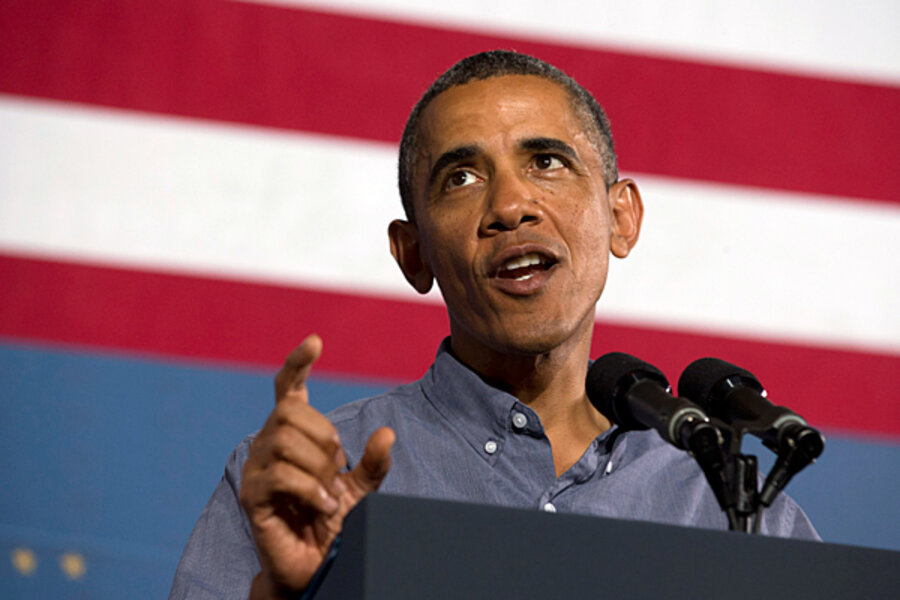US strike on Syria? How far Obama might go.
Loading...
| Washington
The Obama administration appears on the verge of taking military action against Syria.
On Sunday, a senior White House official said in a written statement that there is “very little doubt” the Syrian regime of President Bashar al-Assad had used chemical weapons against its own people. In the past, President Obama has said that such an indiscriminate gas attack would cross a “red line” and draw a US response. Put those two things together, and it’s clear that the US is at least seriously considering some sort of armed response to Syria’s brutality.
Given that, how extensive a strike might the response be?
If Mr. Obama’s past approach to intervention is any guide, the action is likely to be a middle ground between doing nothing and action so forceful it would topple the Assad regime, according to some US foreign-policy experts.
“Most likely that middle-ground response will be targeted attacks against Syrian military units associated with chemical-weapons capacity and infrastructure. But those could be quite punishing and comprehensive,” writes Aaron David Miller, a former State Department official who is now a vice president at the Woodrow Wilson International Center for Scholars in Washington.
Obama’s experience with inherited wars in Iraq and Afghanistan has taught him that means and ends must match, Mr. Miller writes in Politico. Military action needs to be calibrated to what the US wants to accomplish.
“Given his low expectations on what the United States can do to actually end the civil war in Syria, he’ll be very sober about what can be accomplished through any discrete military action,” according to Miller.
And to this point in his presidency, Obama has been a reluctant interventionist.
In Libya, the president allowed France and Britain to take the lead in airstrikes intended to help oust Muammar Qaddafi. To critics, Obama was “leading from behind.”
In Syria, the administration has been reluctant to side with rebel groups looking to oust Mr. Assad, given the Islamist nature of some rebels and the fractured state of the opposition coalition.
In the administration’s view, the struggle in Syria is a deeply rooted conflict among many factions. Fighting is likely to continue even if Assad is ousted. US military options need to be considered in that context, according to the nation’s highest-ranking officer.
“Syria today is not about choosing between two sides but rather about choosing one among many sides,” wrote Gen. Martin Dempsey, chairman of the Joint Chiefs of Staff, in a letter to Rep. Eliot Engel (D) of New York.
It’s possible that the US will enable its allies to strike Syria. This could take the form of providing logistics and intelligence for other nations, such as France, Britain, or Turkey, to take the lead in airstrikes.
That would be consistent with the administration’s generally realist approach to international interventionism, according to Daniel Drezner, professor of international relations at the Fletcher School of Law and Diplomacy at Tufts University in Medford, Mass.
However, while that worked in Libya, it’s not clear that it could succeed in Syria, Professor Drezner adds in a post on his Foreign Policy magazine blog. The Syrian air defense system is far more capable than was Libya’s. Assad’s military appears committed to fighting to the bitter end.
“Is it possible for US forces to play a strictly supporting role that enables French or other forces to take kinetic action in Syria? Or does that option not really exist?” Drezner muses.
The 1999 NATO-led air war over Kosovo may be a precedent and model for US action in Syria. That campaign was multilateral, relied on air power, and achieved its political objective of forcing Serbia to stop fighting and pull back its military; then Kosovo became an autonomous Albanian enclave, writes Slate military expert Fred Kaplan.
However, that result required boots on the ground – tens of thousands of NATO peacekeepers dispatched to the area after fighting stopped. That’s unlikely to be matched in Syria anytime soon.
If Obama does approve military action, what will its objectives be? That’s the crucial question of any military intervention, according to Mr. Kaplan.
“It should be asked, and answered, before a decision is made to intervene – along with a calculation of how much effort might be needed to accomplish those objectives and whether the cost is worth the benefit,” he writes.
Kaplan adds that destruction of Syria’s chemical weapons capability might be difficult, given how easy it is to hide such weapons. More feasible might be destruction of Assad’s air force. That’s something the US could do, wrote Dempsey in his letter to Representative Engel.
“The loss of Assad’s Air Force would negate his ability to attack opposition forces from the air, but it would also escalate and potentially further commit the United States to the conflict,” according to Dempsey.






